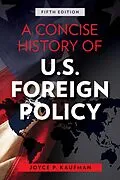Now in a fully updated edition that goes through the Trump administration and the election and formative period of the Biden administration, this compact and accessible introduction offers a historical perspective on the evolution of U.S. foreign policy from the founding of the country to the present. Joyce P. Kaufman provides students and general readers with a clear and concise understanding of key foreign-policy decisions and why they were made. She identifies the major themes that have guided foreign policy and the reasons that the United States pursued certain policies in the context of specific periods in the nation's history. Kaufman focuses on the major actors involved in the making of foreign policy and the changing relationships among them. She also explains the major theoretical perspectives within international relations and contextualizes key foreign policy decisions as they fit these frameworks. This edition puts a particular focus on the creation of Cold War foreign policy, and why the end of the Cold War has continued to be such a challenge to the United States. Kaufman concludes with a look at the challenges the United States will continue to face, including existential threats such as climate change and disease, and how Americans can be prepared to address them.
Autorentext
Joyce P. Kaufman is professor emerita of political science at Whittier College. Her books include Introduction to International Relations: Theory and Practice.
Inhalt
Preface to the Fifth Edition
Part I: The Framework
1 Setting the Stage for Understanding U.S. Foreign Policy
Introduction to U.S. Foreign Policy
What Is Foreign Policy?
National Interest
Foreign Policy Orientations
Unilateralism and Isolationism
Engagement/Internationalism
Theory and Context
Identifying Themes
Who Makes Foreign Policy, and Why Are Particular Decisions Made?
The Actors
Role of Economics
Role of Domestic Politics and Factors
Who Is Affected by U.S. Foreign Policy Decisions?
Impact of U.S. Foreign Policy Decisions on Other Countries
Domestic Constituencies
The Powerless: The Feminist Perspective
Setting the Stage
Primary Sources
Part II: The Formative Years
2 Unilateralism to Engagement: The Founding to the End of World War I, 17771920
The Beginning
Creating a Foreign Policy Framework
Beware of Entangling Alliances
Manifest Destiny, the Monroe Doctrine, and Westward Expansion
The War of 1812
The Monroe Doctrine
Continued Expansion
Mexican-American War
The American Genocide
Expansion into the Pacific
The Civil War
The Spanish-American War
Implications of the Spanish-American War
The Scramble for Concessions
The Roosevelt Corollary to the Monroe Doctrine
March to World War I
Wilsonian Idealism and U.S. Foreign Policy
Wilson's Fourteen Points
U.S. Involvement in Russia
Domestic Issues: The Executive and Legislative Branches
The Shifting National Interest
Chronology from the Founding to the End of World War I
Selected Primary Sources
3 From Isolationism to Superpower: The Interwar Years through World War II, 19201945
Interwar America
U.S. Foreign Policy, 19201930
Escalation to World War II: 19301941
Neutrality Acts
From Neutrality to Nonbelligerency
War
Executive Order 9066
Preparing for Peace
The Impact of World War II
Technology and World War II
The Decision to Bomb Hiroshima and Nagasaki
The United Nations: Defining the Postwar World
Creation of the United Nations
From Isolationism to Engagement
The Domestic Context for the Postwar Period
Chronology, 19201945
Selected Primary Sources
